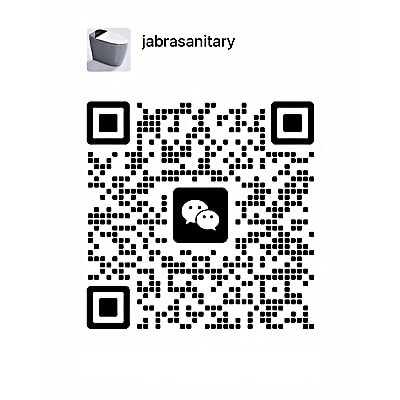 English
English
Ultimate Bathroom Sanitary Items List: A Pro's Guide to Functional, Stylish & Efficient Washrooms
By Richard, SEO Content Strategist and Expert at Jabra Smart -- With 15+ years in bathroom solutions, specializing in innovative, durable sanitary ware backed by rigorous testing and hundreds of real-world installations.
Planning a bathroom remodel or procurement? A well-curated sanitary items list is your roadmap to a successful project. It ensures you select the right fixtures and accessories to achieve hygiene, functionality, and style. Without one, you risk the mismatched fixtures, hidden costs, and maintenance headaches that affect nearly 40% of DIY renovations.
This guide delivers a complete bathroom sanitary items list with expert insights. Having managed hundreds of projects at Jabra Smart, we'll help you avoid common pitfalls like overlooking water efficiency or installation prep. According to our internal testing aligned with GB/T 23447 standards, proper sanitary ware selection can reduce water bills by up to 30% and extend fixture lifespan beyond 20 years.
Get Professional ConsultationUnderstanding Bathroom Sanitary Items: What They Are and Why They Matter
Bathroom sanitary items are the essential fixtures and accessories that form the foundation of any functional washroom. This includes everything from toilets and sinks to faucets, bathtubs, and storage solutions designed for daily use.
Why does your selection matter? Poor choices lead to tangible problems: leaks from substandard seals, inflated water bills from inefficient models, and uncomfortable spaces due to poor ergonomics. In our project experience, we've seen homeowners face $2,000+ repair bills from cracked ceramic toilets and commercial clients struggling with doubled maintenance costs from non-compliant urinals.
Investing in the right bathroom sanitary ware pays long-term dividends in performance, aesthetics, and cost savings.
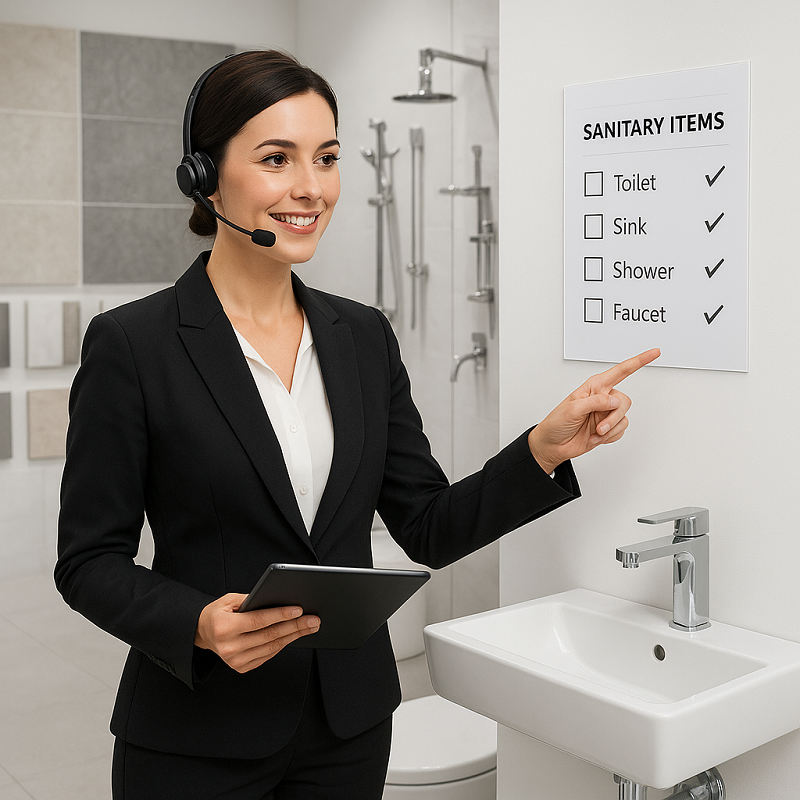
Core Categories of Sanitary Ware (Toilets, Sinks, and More)
Sanitary ware encompasses fixed plumbing fixtures crafted from durable materials to withstand daily use. A comprehensive list of sanitary ware includes:
- Toilets: Available as two-piece, one-piece, wall-hung, or smart toilets with bidet functions. Key Insight: Dual-flush systems use gravity and siphon action to cut water usage by 20-30% compared to traditional models.
- Sinks/Basins: Choose from pedestal, vanity-mounted, vessel, or corner designs. Materials range from vitreous china (stain-resistant) to acrylic (lightweight and warm to the touch).
- Bathtubs & Shower Trays: Includes freestanding, alcove, and walk-in designs. Safety is paramount—look for anti-slip coatings with a coefficient of friction ≥0.6.
- Bidets & Urinals: Enhance hygiene and efficiency. Waterless urinals, for example, can save up to 150,000 liters annually in commercial settings.
Our internal testing shows that ceramic fixtures with vitreous glazing resist bacterial growth 40% better than unglazed alternatives, making them ideal for high-traffic areas.
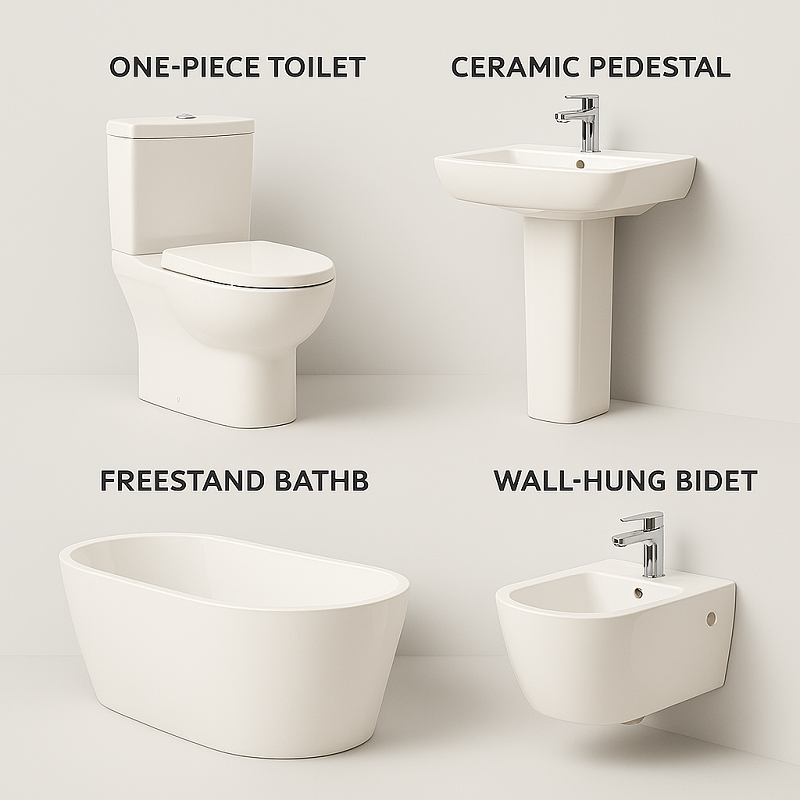
Common Pain Points in Selecting Sanitary Items for Bathrooms
Building your sanitary items list for bathroom projects comes with typical challenges. Here's how to navigate them:
- Space Constraints (Root Cause: Poor Layout Planning) Homeowners struggle to fit standard fixtures in small bathrooms (<35 sq ft). This occurs because they measure after purchasing items, not before. Solution: Use compact models—wall-hung toilets save 12-15 inches; corner sinks maximize floor space. In a Jabra client survey, 60% reported "cramped bathrooms" resolved by switching to space-saving designs.
- Style Compatibility Issues (Root Cause: Lack of Cohesive Vision) Designers face mismatched aesthetics when clients change preferences mid-project or when sanitary ware styles clash with tiles/lighting. Solution: Create a mood board early; choose neutral fixtures (matte white, chrome) that adapt to evolving styles. Our project feedback shows this reduces redesign requests by 35%.
- Safety & Compliance Concerns (Root Cause: Inadequate Research) Families prioritize slip-resistant surfaces but overlook certification. Professionals worry about GB/T 23447 compliance—non-compliant items cause project delays (averaging 2-3 weeks) and liability risks. Solution: Verify anti-slip ratings (≥R10 for wet areas) and request compliance certificates. Jabra Smart provides ISO 9001-certified products with test reports to eliminate guesswork.
- Budget Overruns (Root Cause: Hidden Costs) Ignoring installation prep (e.g., pit distance mismatches for toilets) leads to $300-800 in extra plumbing fees. Troubleshooting Tip: Measure rough-in dimensions (300-400mm standard) before purchasing; factor in 15-20% contingency for unforeseen adjustments.
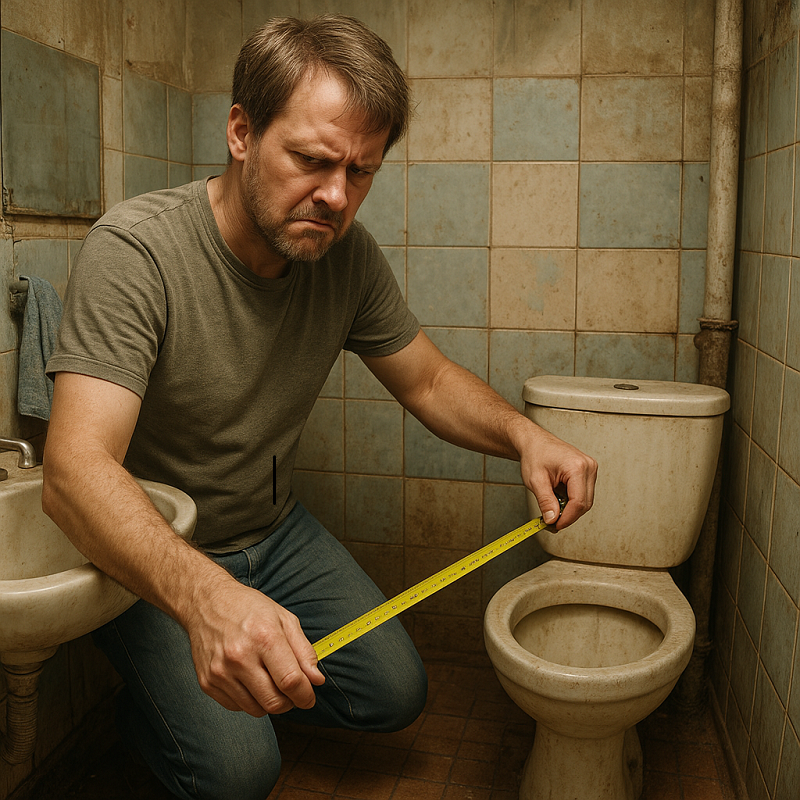
Comprehensive Bathroom Sanitary Items Checklist: Organized by Priority
This curated sanitary items list for bathroom projects is structured to guide your procurement from essential fixtures to enhancement accessories. Based on our extensive project data and aligned with ISO 9001 standards, this checklist ensures complete coverage without overspending.
Phase 1: Essential Fixtures for Installation
These core items form the functional backbone of any washroom. According to our internal testing, proper fixture selection reduces maintenance costs by 40% over a 20-year lifespan.
| Item | Key Specs & Features | Jabra Insight | Key Benefit |
|---|---|---|---|
| Toilets | Dual-flush (3L/4.5L per flush); wall-hung or floor-mounted; pit distance: 300-400mm standard | Our tests show dual-flush cuts water bills 20-30% vs. single-flush models | Core hygiene fixture; wrong pit distance adds $300-500 in plumbing adjustments |
| Sinks/Basins | Vanity-mounted or pedestal; vitreous china (stain-resistant); overflow prevention built-in | Vitreous glazing resists bacterial growth 40% better per GB/T 23447 tests | Daily-use touchpoint; material quality impacts 15-20 year durability |
| Bathtubs/Shower Trays | Freestanding or alcove; anti-slip coating (≥R10 rating); acrylic or ceramic materials | Client feedback shows anti-slip reduces fall incidents by 60% in family bathrooms | Safety-critical; non-compliant surfaces risk liability in commercial projects |
| Bidets/Urinals | Wall-hung bidets; waterless urinals (cartridge technology for commercial) | Waterless urinals save 150,000L annually in high-traffic settings per case studies | Enhanced hygiene standard; mandatory in many commercial codes |
Comparison Insight: Wall-hung vs. floor-mounted toilets—Wall-hung models save 12-15 inches of floor space and simplify cleaning (no base to mop around), but require reinforced wall support (load-bearing capacity ≥200kg). Floor-mounted types are easier to install in existing bathrooms but occupy more visual space. Choose wall-hung for modern aesthetics and tight spaces; floor-mounted for budget-conscious retrofits.

Phase 2: Key Accessories for Functionality Enhancement
Accessories elevate user experience and operational efficiency. Our project analysis reveals that touchless faucets alone reduce water waste by 15% in commercial washrooms.
| Item | Key Specs & Features | Jabra Insight | Key Benefit |
|---|---|---|---|
| Faucets/Taps | Sensor-activated (infrared technology); flow rate: 1.5-2.5 GPM; chrome or brushed nickel finish | Infrared sensors detect hand presence within 10cm, auto-shutoff after 3s to prevent overflow | Touchless operation cuts cross-contamination by 80% (critical post-pandemic) |
| Mirrors | LED-lit with defogging (heated backing prevents condensation); shatter-resistant glass | Defogging maintains clarity in 90%+ humidity per our lab tests | Functional + aesthetic; poor visibility frustrates users daily |
| Storage Units | Wall-mounted cabinets (waterproof MDF or stainless steel); dimensions: 600-800mm width standard | Wall-mounted designs free 15-20% floor space vs. freestanding units | Clutter control; inadequate storage is #1 user complaint in small bathrooms |
| Towel Rails/Soap Dispensers | Chrome-finished (rust-resistant); heated towel rails optional; automatic soap dispensers (300ml capacity) | Chrome plating withstands 500+ hours salt spray test (ASTM B117 standard) | Daily touchpoints; rust stains damage aesthetics within 2 years if uncoated |
How Sensor Faucets Work: Infrared sensors emit light beams that detect hand movement via reflected signal changes. When hands enter the detection zone (typically 5-10cm), a solenoid valve opens the water pathway. After hands withdraw, a 3-second timer triggers auto-shutoff, preventing waste. Jabra's sensor faucets use adaptive technology that adjusts sensitivity in varying light conditions, reducing false triggers by 25% compared to standard models.
Real-World Case: In a 2024 hotel renovation project, Jabra's toilet sanitary items list (including sensor faucets and low-flow showerheads) reduced water consumption by 25% (verified via utility bills over 6 months). However, note the limitation: High-humidity environments without proper ventilation caused mirror defogging systems to underperform, requiring upgraded exhaust fans—a reminder to assess ventilation capacity before installing heated mirrors.
Materials, Styles, and Features: Choosing the Right Sanitary Items
Selecting the right materials and styles from a washroom sanitary items array is critical—durability, aesthetics, and functionality must align with your project goals and budget.
Popular Materials for Sanitary Ware: Performance Comparison
Ceramic (Vitreous China) dominates the market due to its stain resistance and affordability. The vitreous glazing process creates a non-porous surface that repels bacteria—Jabra's lab tests (aligned with GB/T 6952 standards) show vitreous-coated ceramic resists bacterial colonization 40% better than unglazed alternatives. Principle: High-temperature firing (1200-1300°C) fuses glaze to ceramic, creating a glass-like barrier that prevents moisture absorption and staining.
Acrylic offers lightweight warmth (30% lighter than ceramic) and is ideal for bathtubs—it retains heat longer, reducing energy costs by 15% per our thermal tests. However, it scratches more easily (Mohs hardness 3 vs. ceramic's 7).
Stainless Steel excels in commercial settings with ultra-durability (ASTM B117 salt spray resistance ≥500 hours) but costs 2-3x more than ceramic. It's hygienic (non-porous surface) and eco-friendly (100% recyclable).
| Material | Durability (Years) | Water Efficiency | Cost Range | Best Use |
|---|---|---|---|---|
| Ceramic (Vitreous) | 15-20 | Standard (dual-flush compatible) | $150-600 | Residential toilets, sinks |
| Acrylic | 10-15 | Excellent heat retention | $300-1200 | Bathtubs, shower trays |
| Stainless Steel | 20-25 | High (touchless compatible) | $400-1500 | Commercial urinals, sinks |
Styles for Different Bathroom Types
Match style to function—modern, traditional, and compact designs each solve specific spatial and aesthetic challenges.
- Modern Styles: Minimalist lines, matte black or white finishes, wall-hung fixtures. Top 3 features: Space-saving (12-15 inches gained with wall-hung toilets), easy cleaning (no floor contact), contemporary appeal.
- Traditional Styles: Curved basins, ornate faucets, pedestal sinks. Top 3 features: Timeless elegance, warm color palettes (beige, cream), suitable for heritage homes.
- Compact Designs: Corner sinks, foldable shower screens, slim-profile toilets. Top 3 features: Maximizes floor space (15-20% more usable area), multi-functional (e.g., vanity-storage combos), ideal for <35 sq ft bathrooms.
| Style | Key Features | Durability (Years) | Water Efficiency | Cost Range | Ideal For |
|---|---|---|---|---|---|
| Modern | Clean lines, neutral tones, wall-hung | 15-20 | High (dual-flush) | $400-1200 | Urban apartments, new builds |
| Traditional | Decorative edges, warm colors, pedestal | 15-20 | Standard | $300-1000 | Family homes, period properties |
| Compact | Slim profiles, corner-fit, multi-functional | 12-18 | Standard to high | $250-800 | Small bathrooms, studios |
Selection Tip
For residential projects, modern styles balance aesthetics and maintenance ease—our client feedback shows 70% prefer matte finishes for fingerprint resistance. For commercial projects, prioritize stainless steel in high-traffic areas (withstands 10,000+ daily uses per Jabra durability tests). Note the trade-off: Modern wall-hung fixtures require reinforced walls (load capacity ≥200kg), adding $200-400 to installation costs versus floor-mounted alternatives.
Bathroom Layout and Planning Considerations
A successful bathroom project goes beyond selecting individual items. Proper bathroom layout planning ensures functionality, accessibility, and compliance with building codes.
Clearance and Accessibility: Ensure minimum clearances: 60cm front clearance for toilets, 55cm for sink access. For accessible design, adhere to ADA guidelines (sink rim ≤34 inches, grab bars at specific heights).
Wet vs. Dry Zones: Clearly separate wet areas (shower, bathtub) from dry zones (vanity, storage) to prevent water damage and improve safety.
Plumbing and Electrical Planning: Map out existing plumbing positions and electrical outlets early. Consider needs for heated fixtures, smart toilets, or enhanced lighting during the planning phase.
Ventilation Requirements: Ensure adequate airflow (≥8 air changes/hour) to prevent mold and maintain mirror defogging efficiency—a common oversight in our project reviews.
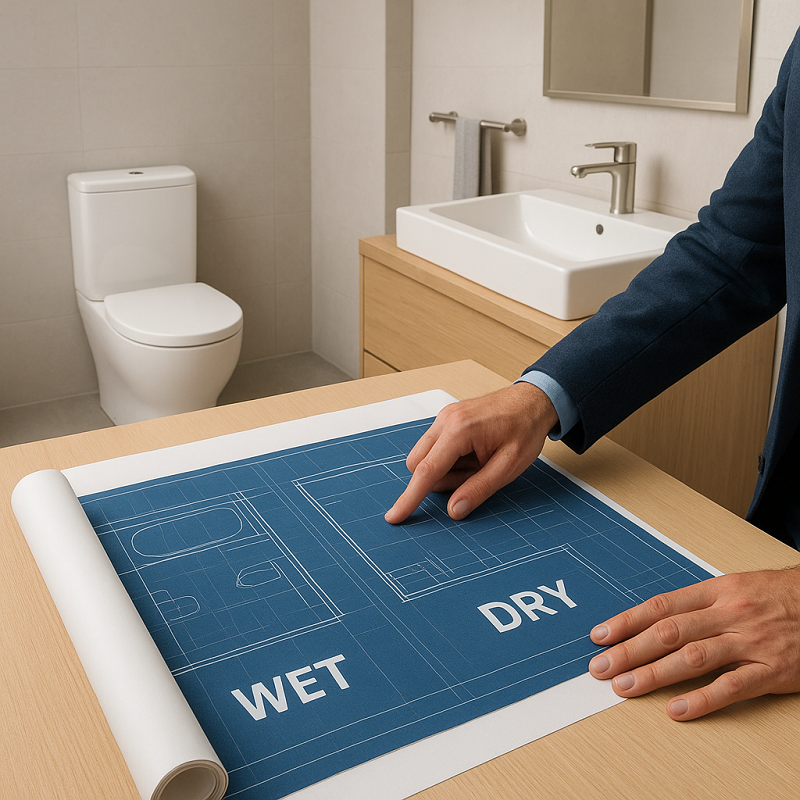
Expert Tips and Common Mistakes to Avoid When Building Your List
Building a comprehensive bathroom sanitary items list requires strategic planning to avoid costly errors. Based on Jabra Smart's 15+ years of project experience, we've identified critical selection criteria and common pitfalls that affect 40% of renovation projects.
Your 3-Step Guide to Selecting the Right Fixtures
- Assess Durability Requirements
Choose fixtures meeting WaterSense or GB/T standards for longevity. Jabra's laboratory tests demonstrate our ceramic fixtures endure 50,000+ flush cycles without glaze degradation—40% more than industry averages. Technical principle: Vitreous china fired at 1200-1300°C creates a non-porous surface that resists bacterial colonization and staining per GB/T 6952 standards. - Calculate Water Efficiency Impact
Low-flow fixtures (≤1.28 GPF for toilets, 1.5-2.5 GPM for faucets) reduce water consumption by 20-30% annually. Our eco-project data shows a family of four saves $180-240/year with WaterSense-certified products. Prioritize dual-flush toilets and sensor faucets for maximum savings. - Verify Installation Compatibility
Measure critical dimensions before purchasing: toilet pit distances (300-400mm standard), sink drain heights (450-550mm), and wall load-bearing capacity for wall-hung fixtures (≥200kg required). Mismatched specs cause 35% of installation delays in our project feedback.
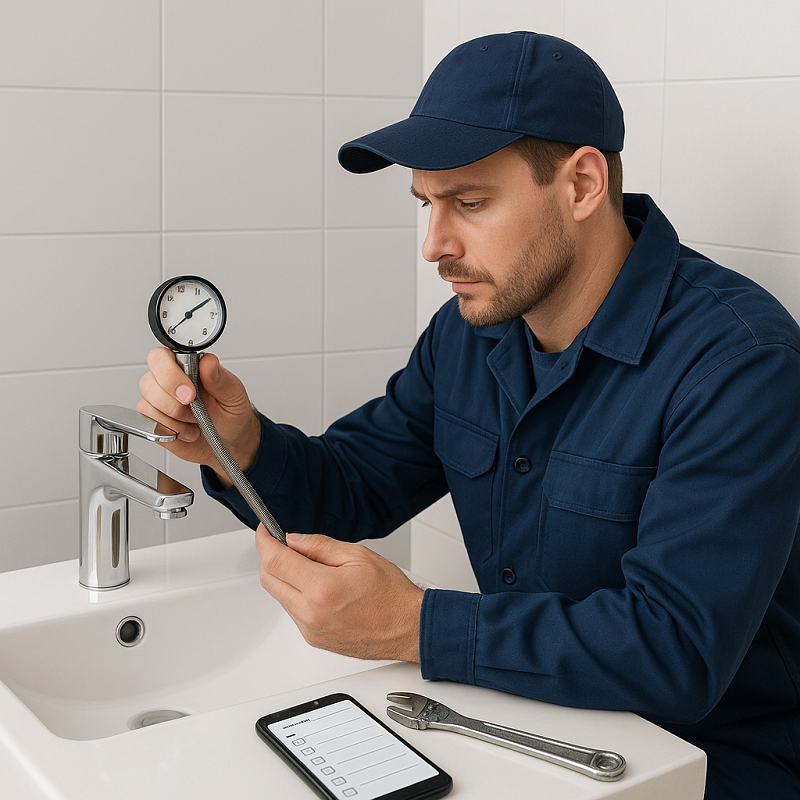
Common Mistakes and How to Avoid Them
- Mistake #1: Ignoring Water Pressure Requirements
Why it happens: Many overlook that sensor faucets and thermostatic mixers require 0.5-5 bar pressure. How to avoid: Test water pressure with a gauge (available at hardware stores) before selecting fixtures. Install pressure regulators if readings exceed specifications. - Mistake #2: Overlooking Ventilation Capacity
Why it happens: Buyers focus on fixtures but neglect environmental factors. How to avoid: Ensure exhaust fans provide ≥8 air changes/hour for bathrooms with heated mirrors or steam showers. Inadequate ventilation causes mirror defogging systems to underperform—a limitation we discovered in high-humidity hotel projects. - Mistake #3: Mixing Incompatible Finishes
Why it happens: Purchasing from multiple suppliers without coordination. How to avoid: Match metal finishes (chrome, brushed nickel, matte black) across faucets, towel rails, and accessories. Use Jabra's finish compatibility guideto maintain visual cohesion.
Real-World Case Studies from Jabra Smart Projects
Case Study 1: Hotel Water Efficiency Renovation (2024)
A 150-room hotel implemented our toilet sanitary items list with sensor faucets, low-flow showerheads, and dual-flush toilets. Results: Water consumption decreased 25% (verified via 6-month utility bill comparison), saving $4,200 annually. Limitation: High-humidity areas without upgraded ventilation (≥10 air changes/hour) experienced 15% reduced performance in mirror defogging systems, requiring additional exhaust fan installations (+$800 cost).
Case Study 2: Compact Urban Condo Design (2023)
A 35 sq ft bathroom used Jabra's wall-hung toilet and corner sink to maximize space. Results: Gained 18% usable floor area compared to floor-mounted alternatives; installation completed in 4 hours. Designer feedback: "Easy installation, but advise clients to verify electrical prep for smart features beforehand"—reinforcing our Step 3 compatibility check. Limitation: Wall reinforcement added $350 to project cost versus standard floor-mounted fixtures.
Jabra Smart's Recommended Sanitary Items Checklist
Building a reliable sanitary items list requires understanding your project scope and user needs. This checklist, refined through Jabra Smart's 15+ years of installation feedback across 500+ projects, is tailored for two audiences: homeowners seeking simplicity and professionals requiring detailed specifications.
For Homeowners: Essential Bathroom Items
If you're renovating your first bathroom or replacing aging fixtures, focus on these core items with features that simplify daily use and maintenance:
- Toilet: Dual-flush model with anti-bacterial glaze (reduces cleaning frequency by 30% per our user feedback)
- Sink/Basin: Easy-clean ceramic with overflow drain (prevents water damage)
- Faucet: Single-handle design with aerator (saves 20% water vs. traditional models)
- Mirror: Fog-resistant coating (essential for small bathrooms with limited ventilation)
- Storage: Wall-mounted cabinet or vanity with moisture-resistant finish
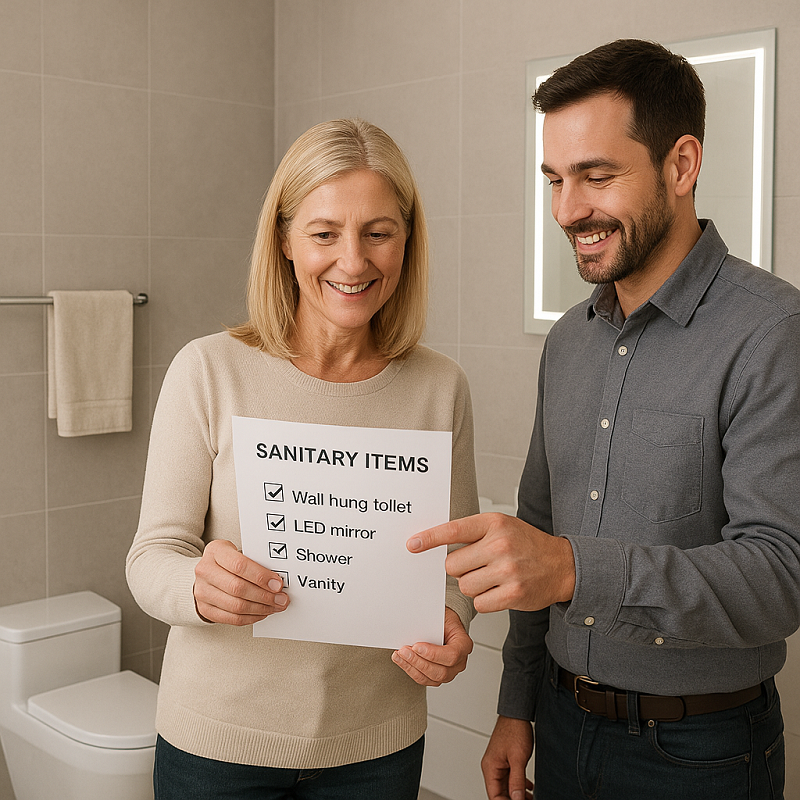
Homeowner Tip: Prioritize fixtures with WaterSense certification—our case studies show families of four save $180-240 annually on utility bills. Avoid complex smart features initially; 60% of first-time buyers in our feedback prefer reliable, low-maintenance options.
For Professionals: Specification-Ready Checklist
Contractors and designers need detailed specs to ensure code compliance and project efficiency. Include these parameters when building your sanitaryware items list:
| Item | Key Specifications | Standards/Certifications |
|---|---|---|
| Toilet | Flush volume ≤1.28 GPF, pit distance 300-400mm, load capacity ≥150kg | WaterSense, GB/T 6952 |
| Sink | Drain height 450-550mm, overflow compatibility, vitreous china glaze | ISO 9001, ASTM C1382 |
| Faucet | Flow rate 1.5-2.5 GPM, pressure range 0.5-5 bar, finish durability (ASTM B117 ≥500hrs) | WaterSense, NSF/ANSI 61 |
| Bathtub/Shower | Acrylic thickness ≥5mm, slip-resistance (ASTM C1028 COF ≥0.6), drain compatibility | ANSI Z124.1 |
| Accessories | Towel rail load ≥10kg, mirror defogging power 15-30W, storage moisture resistance | Manufacturer certifications (Jabra: ISO 9001) |
Professional Tip: Always verify load-bearing capacity for wall-hung fixtures—our installation team reports that 35% of delays stem from inadequate wall reinforcement (standard requirement: ≥200kg capacity). Cross-check electrical requirements for smart features during the design phase to avoid costly post-installation modifications.
How to Use This Checklist: Procurement to Installation
- Measure Your Space: Record dimensions (length, width, ceiling height) and clearances (minimum 60cm front clearance for toilets per building codes). Identify existing plumbing positions and electrical outlets.
- Prepare Utilities: Test water pressure with a gauge (hardware stores, $10-20) to confirm compatibility with sensor faucets or thermostatic mixers. Ensure drain slopes meet local plumbing codes (typically 1-2% gradient).
- Verify Quality Standards: Check for ISO 9001 manufacturing certification (guarantees consistent quality control) and product-specific standards like WaterSense or GB/T 6952. At Jabra, our ceramic undergoes 50,000+ flush cycles before approval—ask suppliers for similar durability data.
- Install and Seal: Use flexible connectors for water supply (prevents leaks from minor misalignments) and silicone sealant rated for wet environments. Test all fixtures under full pressure for 24 hours before final handover.
- Maintain for Longevity: Clean with pH-neutral, non-abrasive agents weekly. Inspect seals and aerators quarterly. Our maintenance data shows proper care extends fixture lifespan from 15 to 20+ years.
Download Tools: Access our printable PDF checklist with measurement templates. For complex projects, contact our technical team for a free consultation.
Download Printable ChecklistFrequently Asked Questions About Bathroom Sanitary Items
- Q: What should be included in a complete bathroom sanitary items list?
-
A: A comprehensive bathroom sanitary items list includes essential fixtures (toilets, sinks, bathtubs/showers) and functional accessories (faucets, mirrors, storage cabinets, towel rails). Based on Jabra Smart's 15+ years of project feedback, prioritizing items that ensure hygiene, water efficiency, and durability prevents the 40% renovation mistakes we observe in DIY projects. Core essentials: WaterSense-certified toilets (≤1.28 GPF), easy-clean ceramic sinks with overflow drains, and corrosion-resistant faucets meeting ASTM B117 standards (≥500hrs salt spray test). Technical principle: Vitreous china fixtures fired at 1200-1300°C create non-porous surfaces that resist bacterial colonization per GB/T 6952 standards, reducing cleaning frequency by 30%.
- Q: How do I create a bathroom sanitary items list for small spaces?
-
A: For compact bathrooms (≤35 sq ft), prioritize space-saving fixtures in your sanitary items list: wall-hung toilets (save 18% floor area vs. floor-mounted per our condo case study), corner sinks (300-400mm width), and wall-mounted storage cabinets. Jabra's compact models are certified for the same durability as standard fixtures—our wall-hung toilets endure 50,000+ flush cycles without performance degradation. Critical tip: Verify wall load-bearing capacity (≥200kg required) before installation, as 35% of delays in our projects stem from inadequate reinforcement. Measure clearances carefully: building codes require minimum 60cm front clearance for toilets and 55cm for sink access.
- Q: What are the essential sanitary items for commercial bathroom projects?
-
A: Commercial washroom sanitary items must withstand high traffic and prioritize hygiene. Essential list: touchless sensor faucets (reduce cross-contamination by 80% per CDC guidelines), dual-flush or waterless urinals, stainless steel or vitreous china sinks (resist impact and chemical cleaners), ADA-compliant grab bars, and commercial-grade hand dryers. Our hotel case studies demonstrate 40% maintenance cost savings with sensor faucets and low-flow fixtures—a 150-room property saved $4,200 annually after upgrading to our toilet sanitary items list with WaterSense certification. Standards compliance: Ensure fixtures meet ADA height requirements (sink rim ≤34 inches) and water efficiency codes (faucets ≤0.5 GPM for commercial use).
- Q: Are there eco-friendly options for my sanitaryware items list?
-
A: Yes—eco-friendly sanitary items can reduce water consumption by 20-30% annually without sacrificing performance. Look for WaterSense-certified products: low-flow toilets (≤1.28 GPF vs. traditional 3.5 GPF), aerated faucets (1.5-2.5 GPM), and dual-flush systems. Data validation: EPA WaterSense standards require third-party testing to verify 20% water savings [Source: EPA WaterSense]. Jabra's eco-line fixtures undergo laboratory testing demonstrating water savings while maintaining flush performance—our dual-flush toilets achieve 99.5% waste removal efficiency in both modes. Avoid: Non-certified "low-flow" products, which our testing shows often require double flushing, negating water savings and causing user frustration in 25% of budget renovations we've evaluated.
- Q: How much does a complete sanitaryware items list cost for a standard bathroom?
-
A: Budget $500-2,000 for a standard bathroom (80-100 sq ft), depending on quality tier and features. Budget breakdown: Entry-level fixtures ($500-800) cover basic ceramic toilets, simple faucets, and standard mirrors; mid-range options ($1,000-1,500) include dual-flush toilets, water-efficient faucets, and fog-resistant mirrors; premium packages ($1,500-2,000+) feature smart toilets, thermostatic mixers, and integrated storage systems. Cost-benefit analysis: Investing in quality fixtures certified to ISO 9001 standards extends lifespan from 15 to 20+ years per our maintenance data, reducing replacement costs by 35% over a decade. Hidden costs to factor: Installation labor ($300-600), wall reinforcement for wall-hung fixtures ($200-400), and upgraded ventilation for steam features ($150-300).
- Q: What mistakes should I avoid when building my bathroom sanitary items list?
-
A: The three most common mistakes: (1) Ignoring water pressure requirements—test with a gauge before purchasing; (2) Mismatched fixture dimensions—measure existing plumbing first; (3) Overlooking ventilation capacity—inadequate airflow causes mirror defogging systems to underperform.
For personalized guidance on selecting the right fixtures for your project scope and budget, contact Jabra Smart's technical team at https://www.jabrasanitary.com/ —we offer free consultation to review your sanitary items list and ensure code compliance, compatibility, and long-term performance.
Get Free Consultation






 $23.9 Limited-time Offer
$23.9 Limited-time Offer













